Hongyao Tang
Embodied Arena: A Comprehensive, Unified, and Evolving Evaluation Platform for Embodied AI
Sep 18, 2025Abstract:Embodied AI development significantly lags behind large foundation models due to three critical challenges: (1) lack of systematic understanding of core capabilities needed for Embodied AI, making research lack clear objectives; (2) absence of unified and standardized evaluation systems, rendering cross-benchmark evaluation infeasible; and (3) underdeveloped automated and scalable acquisition methods for embodied data, creating critical bottlenecks for model scaling. To address these obstacles, we present Embodied Arena, a comprehensive, unified, and evolving evaluation platform for Embodied AI. Our platform establishes a systematic embodied capability taxonomy spanning three levels (perception, reasoning, task execution), seven core capabilities, and 25 fine-grained dimensions, enabling unified evaluation with systematic research objectives. We introduce a standardized evaluation system built upon unified infrastructure supporting flexible integration of 22 diverse benchmarks across three domains (2D/3D Embodied Q&A, Navigation, Task Planning) and 30+ advanced models from 20+ worldwide institutes. Additionally, we develop a novel LLM-driven automated generation pipeline ensuring scalable embodied evaluation data with continuous evolution for diversity and comprehensiveness. Embodied Arena publishes three real-time leaderboards (Embodied Q&A, Navigation, Task Planning) with dual perspectives (benchmark view and capability view), providing comprehensive overviews of advanced model capabilities. Especially, we present nine findings summarized from the evaluation results on the leaderboards of Embodied Arena. This helps to establish clear research veins and pinpoint critical research problems, thereby driving forward progress in the field of Embodied AI.
Squeeze the Soaked Sponge: Efficient Off-policy Reinforcement Finetuning for Large Language Model
Jul 09, 2025Abstract:Reinforcement Learning (RL) has demonstrated its potential to improve the reasoning ability of Large Language Models (LLMs). One major limitation of most existing Reinforcement Finetuning (RFT) methods is that they are on-policy RL in nature, i.e., data generated during the past learning process is not fully utilized. This inevitably comes at a significant cost of compute and time, posing a stringent bottleneck on continuing economic and efficient scaling. To this end, we launch the renaissance of off-policy RL and propose Reincarnating Mix-policy Proximal Policy Gradient (ReMix), a general approach to enable on-policy RFT methods like PPO and GRPO to leverage off-policy data. ReMix consists of three major components: (1) Mix-policy proximal policy gradient with an increased Update-To-Data (UTD) ratio for efficient training; (2) KL-Convex policy constraint to balance the trade-off between stability and flexibility; (3) Policy reincarnation to achieve a seamless transition from efficient early-stage learning to steady asymptotic improvement. In our experiments, we train a series of ReMix models upon PPO, GRPO and 1.5B, 7B base models. ReMix shows an average Pass@1 accuracy of 52.10% (for 1.5B model) with 0.079M response rollouts, 350 training steps and achieves 63.27%/64.39% (for 7B model) with 0.007M/0.011M response rollouts, 50/75 training steps, on five math reasoning benchmarks (i.e., AIME'24, AMC'23, Minerva, OlympiadBench, and MATH500). Compared with 15 recent advanced models, ReMix shows SOTA-level performance with an over 30x to 450x reduction in training cost in terms of rollout data volume. In addition, we reveal insightful findings via multifaceted analysis, including the implicit preference for shorter responses due to the Whipping Effect of off-policy discrepancy, the collapse mode of self-reflection behavior under the presence of severe off-policyness, etc.
Can We Optimize Deep RL Policy Weights as Trajectory Modeling?
Mar 06, 2025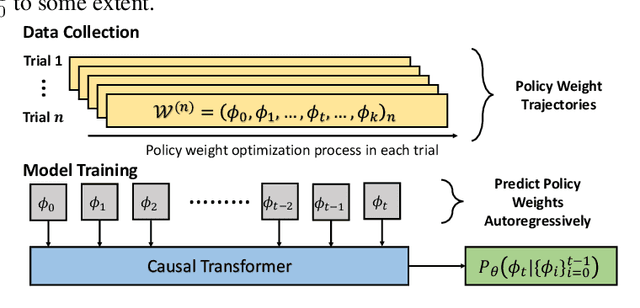
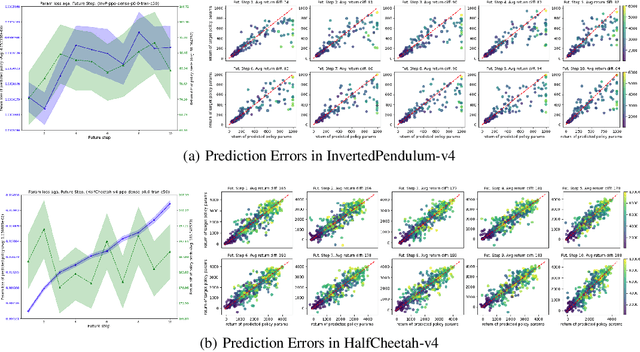
Abstract:Learning the optimal policy from a random network initialization is the theme of deep Reinforcement Learning (RL). As the scale of DRL training increases, treating DRL policy network weights as a new data modality and exploring the potential becomes appealing and possible. In this work, we focus on the policy learning path in deep RL, represented by the trajectory of network weights of historical policies, which reflects the evolvement of the policy learning process. Taking the idea of trajectory modeling with Transformer, we propose Transformer as Implicit Policy Learner (TIPL), which processes policy network weights in an autoregressive manner. We collect the policy learning path data by running independent RL training trials, with which we then train our TIPL model. In the experiments, we demonstrate that TIPL is able to fit the implicit dynamics of policy learning and perform the optimization of policy network by inference.
Dual Ensembled Multiagent Q-Learning with Hypernet Regularizer
Feb 04, 2025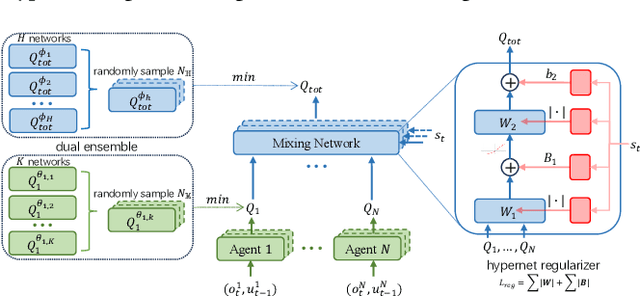
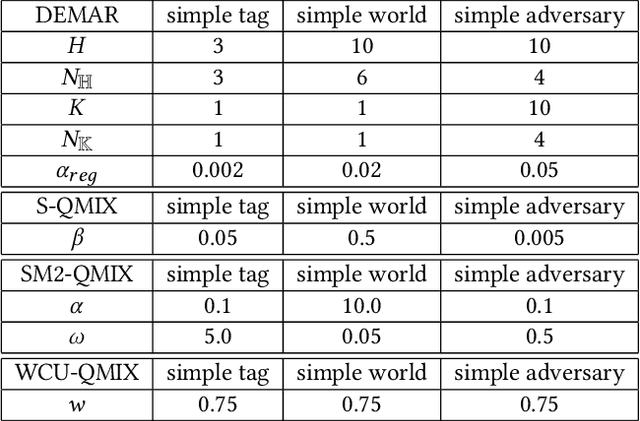
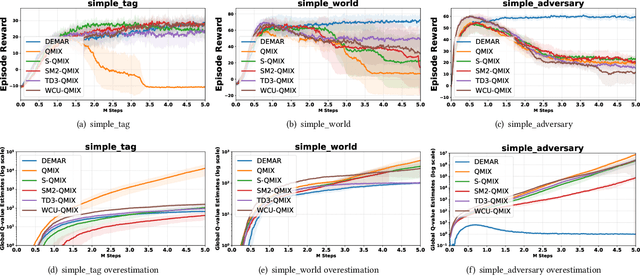
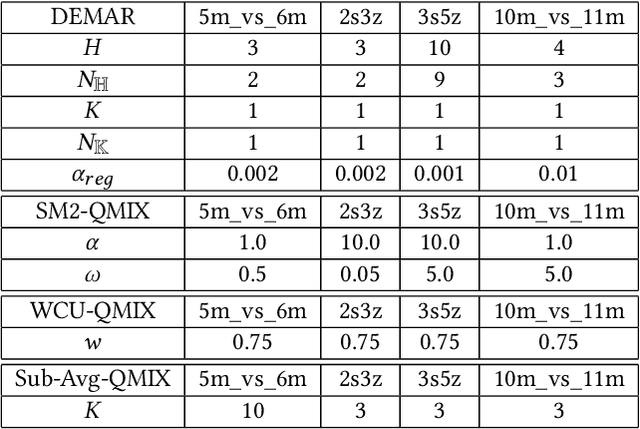
Abstract:Overestimation in single-agent reinforcement learning has been extensively studied. In contrast, overestimation in the multiagent setting has received comparatively little attention although it increases with the number of agents and leads to severe learning instability. Previous works concentrate on reducing overestimation in the estimation process of target Q-value. They ignore the follow-up optimization process of online Q-network, thus making it hard to fully address the complex multiagent overestimation problem. To solve this challenge, in this study, we first establish an iterative estimation-optimization analysis framework for multiagent value-mixing Q-learning. Our analysis reveals that multiagent overestimation not only comes from the computation of target Q-value but also accumulates in the online Q-network's optimization. Motivated by it, we propose the Dual Ensembled Multiagent Q-Learning with Hypernet Regularizer algorithm to tackle multiagent overestimation from two aspects. First, we extend the random ensemble technique into the estimation of target individual and global Q-values to derive a lower update target. Second, we propose a novel hypernet regularizer on hypernetwork weights and biases to constrain the optimization of online global Q-network to prevent overestimation accumulation. Extensive experiments in MPE and SMAC show that the proposed method successfully addresses overestimation across various tasks.
Improving Deep Reinforcement Learning by Reducing the Chain Effect of Value and Policy Churn
Sep 07, 2024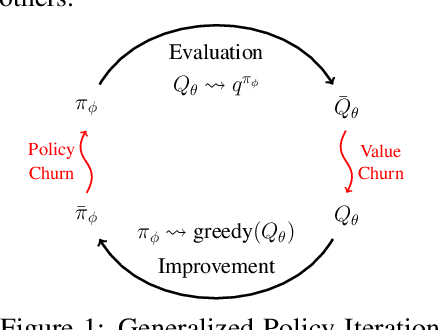

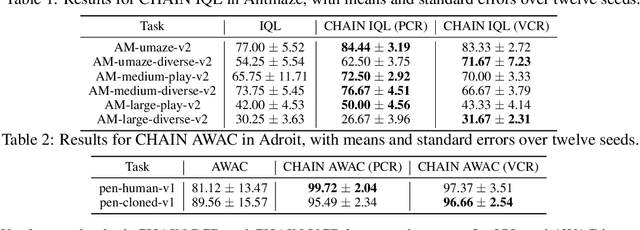

Abstract:Deep neural networks provide Reinforcement Learning (RL) powerful function approximators to address large-scale decision-making problems. However, these approximators introduce challenges due to the non-stationary nature of RL training. One source of the challenges in RL is that output predictions can churn, leading to uncontrolled changes after each batch update for states not included in the batch. Although such a churn phenomenon exists in each step of network training, how churn occurs and impacts RL remains under-explored. In this work, we start by characterizing churn in a view of Generalized Policy Iteration with function approximation, and we discover a chain effect of churn that leads to a cycle where the churns in value estimation and policy improvement compound and bias the learning dynamics throughout the iteration. Further, we concretize the study and focus on the learning issues caused by the chain effect in different settings, including greedy action deviation in value-based methods, trust region violation in proximal policy optimization, and dual bias of policy value in actor-critic methods. We then propose a method to reduce the chain effect across different settings, called Churn Approximated ReductIoN (CHAIN), which can be easily plugged into most existing DRL algorithms. Our experiments demonstrate the effectiveness of our method in both reducing churn and improving learning performance across online and offline, value-based and policy-based RL settings, as well as a scaling setting.
MFE-ETP: A Comprehensive Evaluation Benchmark for Multi-modal Foundation Models on Embodied Task Planning
Jul 06, 2024Abstract:In recent years, Multi-modal Foundation Models (MFMs) and Embodied Artificial Intelligence (EAI) have been advancing side by side at an unprecedented pace. The integration of the two has garnered significant attention from the AI research community. In this work, we attempt to provide an in-depth and comprehensive evaluation of the performance of MFM s on embodied task planning, aiming to shed light on their capabilities and limitations in this domain. To this end, based on the characteristics of embodied task planning, we first develop a systematic evaluation framework, which encapsulates four crucial capabilities of MFMs: object understanding, spatio-temporal perception, task understanding, and embodied reasoning. Following this, we propose a new benchmark, named MFE-ETP, characterized its complex and variable task scenarios, typical yet diverse task types, task instances of varying difficulties, and rich test case types ranging from multiple embodied question answering to embodied task reasoning. Finally, we offer a simple and easy-to-use automatic evaluation platform that enables the automated testing of multiple MFMs on the proposed benchmark. Using the benchmark and evaluation platform, we evaluated several state-of-the-art MFMs and found that they significantly lag behind human-level performance. The MFE-ETP is a high-quality, large-scale, and challenging benchmark relevant to real-world tasks.
Bridging Evolutionary Algorithms and Reinforcement Learning: A Comprehensive Survey
Jan 22, 2024Abstract:Evolutionary Reinforcement Learning (ERL), which integrates Evolutionary Algorithms (EAs) and Reinforcement Learning (RL) for optimization, has demonstrated remarkable performance advancements. By fusing the strengths of both approaches, ERL has emerged as a promising research direction. This survey offers a comprehensive overview of the diverse research branches in ERL. Specifically, we systematically summarize recent advancements in relevant algorithms and identify three primary research directions: EA-assisted optimization of RL, RL-assisted optimization of EA, and synergistic optimization of EA and RL. Following that, we conduct an in-depth analysis of each research direction, organizing multiple research branches. We elucidate the problems that each branch aims to tackle and how the integration of EA and RL addresses these challenges. In conclusion, we discuss potential challenges and prospective future research directions across various research directions.
The Ladder in Chaos: A Simple and Effective Improvement to General DRL Algorithms by Policy Path Trimming and Boosting
Mar 02, 2023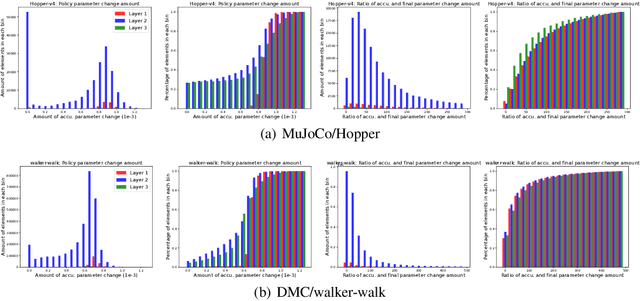
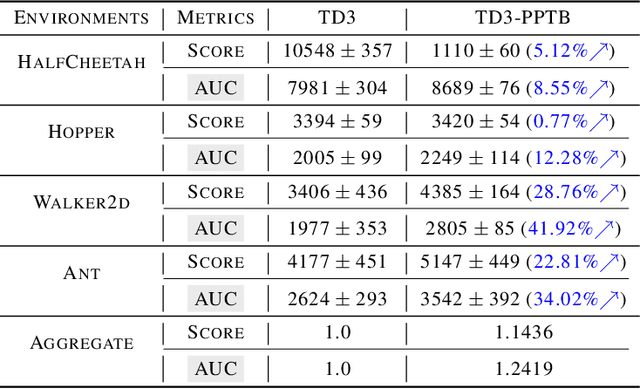
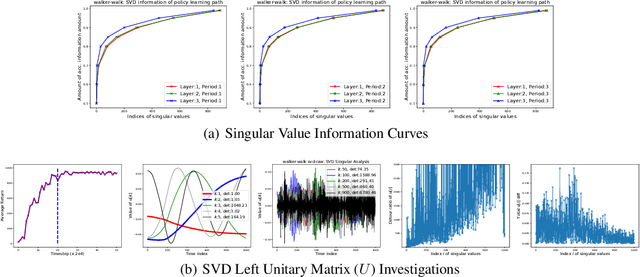
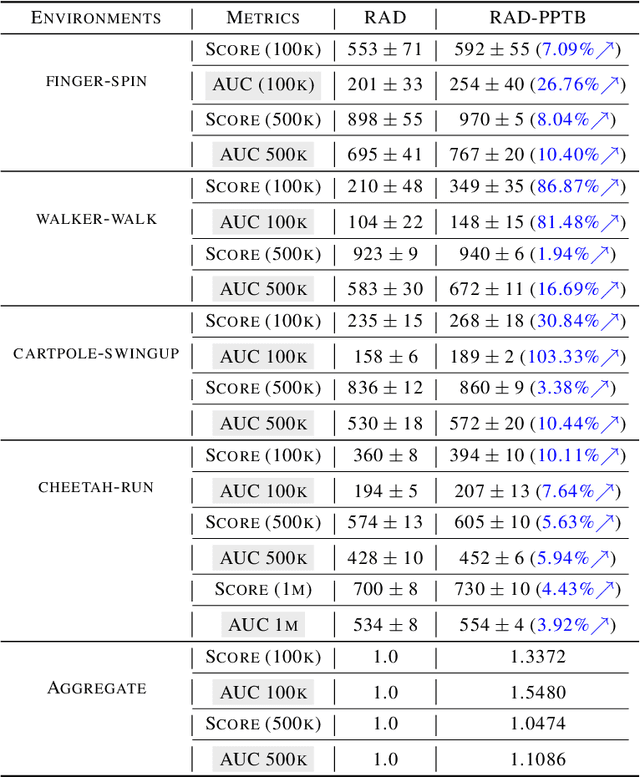
Abstract:Knowing the learning dynamics of policy is significant to unveiling the mysteries of Reinforcement Learning (RL). It is especially crucial yet challenging to Deep RL, from which the remedies to notorious issues like sample inefficiency and learning instability could be obtained. In this paper, we study how the policy networks of typical DRL agents evolve during the learning process by empirically investigating several kinds of temporal change for each policy parameter. On typical MuJoCo and DeepMind Control Suite (DMC) benchmarks, we find common phenomena for TD3 and RAD agents: 1) the activity of policy network parameters is highly asymmetric and policy networks advance monotonically along very few major parameter directions; 2) severe detours occur in parameter update and harmonic-like changes are observed for all minor parameter directions. By performing a novel temporal SVD along policy learning path, the major and minor parameter directions are identified as the columns of right unitary matrix associated with dominant and insignificant singular values respectively. Driven by the discoveries above, we propose a simple and effective method, called Policy Path Trimming and Boosting (PPTB), as a general plug-in improvement to DRL algorithms. The key idea of PPTB is to periodically trim the policy learning path by canceling the policy updates in minor parameter directions, while boost the learning path by encouraging the advance in major directions. In experiments, we demonstrate the general and significant performance improvements brought by PPTB, when combined with TD3 and RAD in MuJoCo and DMC environments respectively.
State-Aware Proximal Pessimistic Algorithms for Offline Reinforcement Learning
Nov 28, 2022Abstract:Pessimism is of great importance in offline reinforcement learning (RL). One broad category of offline RL algorithms fulfills pessimism by explicit or implicit behavior regularization. However, most of them only consider policy divergence as behavior regularization, ignoring the effect of how the offline state distribution differs with that of the learning policy, which may lead to under-pessimism for some states and over-pessimism for others. Taking account of this problem, we propose a principled algorithmic framework for offline RL, called \emph{State-Aware Proximal Pessimism} (SA-PP). The key idea of SA-PP is leveraging discounted stationary state distribution ratios between the learning policy and the offline dataset to modulate the degree of behavior regularization in a state-wise manner, so that pessimism can be implemented in a more appropriate way. We first provide theoretical justifications on the superiority of SA-PP over previous algorithms, demonstrating that SA-PP produces a lower suboptimality upper bound in a broad range of settings. Furthermore, we propose a new algorithm named \emph{State-Aware Conservative Q-Learning} (SA-CQL), by building SA-PP upon representative CQL algorithm with the help of DualDICE for estimating discounted stationary state distribution ratios. Extensive experiments on standard offline RL benchmark show that SA-CQL outperforms the popular baselines on a large portion of benchmarks and attains the highest average return.
ERL-Re$^2$: Efficient Evolutionary Reinforcement Learning with Shared State Representation and Individual Policy Representation
Oct 26, 2022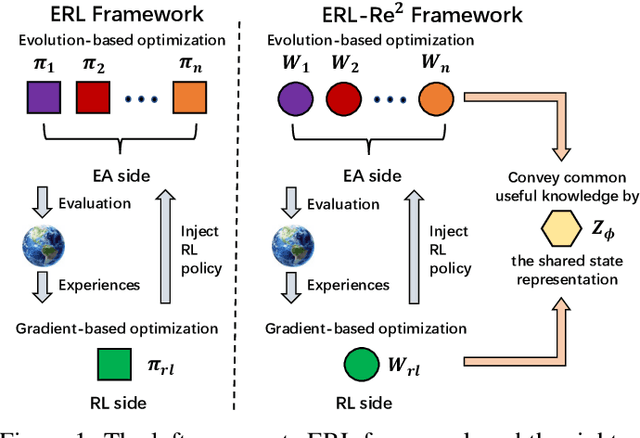

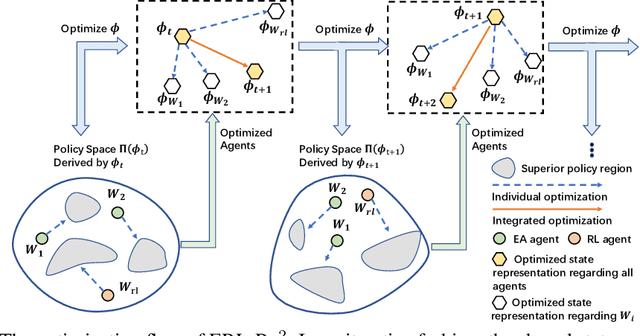
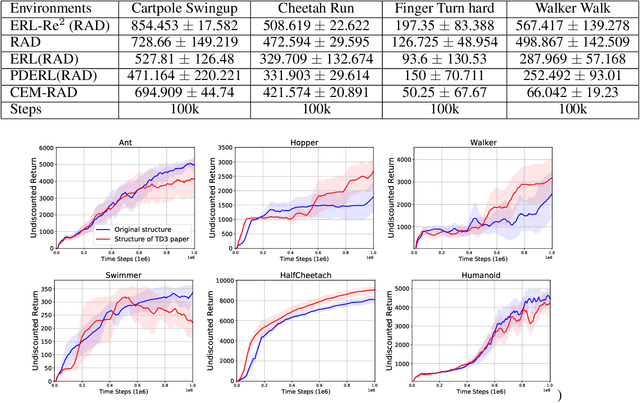
Abstract:Deep Reinforcement Learning (Deep RL) and Evolutionary Algorithm (EA) are two major paradigms of policy optimization with distinct learning principles, i.e., gradient-based v.s. gradient free. An appealing research direction is integrating Deep RL and EA to devise new methods by fusing their complementary advantages. However, existing works on combining Deep RL and EA have two common drawbacks: 1) the RL agent and EA agents learn their policies individually, neglecting efficient sharing of useful common knowledge; 2) parameter-level policy optimization guarantees no semantic level of behavior evolution for the EA side. In this paper, we propose Evolutionary Reinforcement Learning with Two-scale State Representation and Policy Representation (ERL-Re2), a novel solution to the aforementioned two drawbacks. The key idea of ERL-Re2 is two-scale representation: all EA and RL policies share the same nonlinear state representation while maintaining individual linear policy representations. The state representation conveys expressive common features of the environment learned by all the agents collectively; the linear policy representation provides a favorable space for efficient policy optimization, where novel behavior-level crossover and mutation operations can be performed. Moreover, the linear policy representation allows convenient generalization of policy fitness with the help of Policy-extended Value Function Approximator (PeVFA), further improving the sample efficiency of fitness estimation. The experiments on a range of continuous control tasks show that ERL-Re2 consistently outperforms strong baselines and achieves significant improvement over both its Deep RL and EA components.
 Add to Chrome
Add to Chrome Add to Firefox
Add to Firefox Add to Edge
Add to Edge